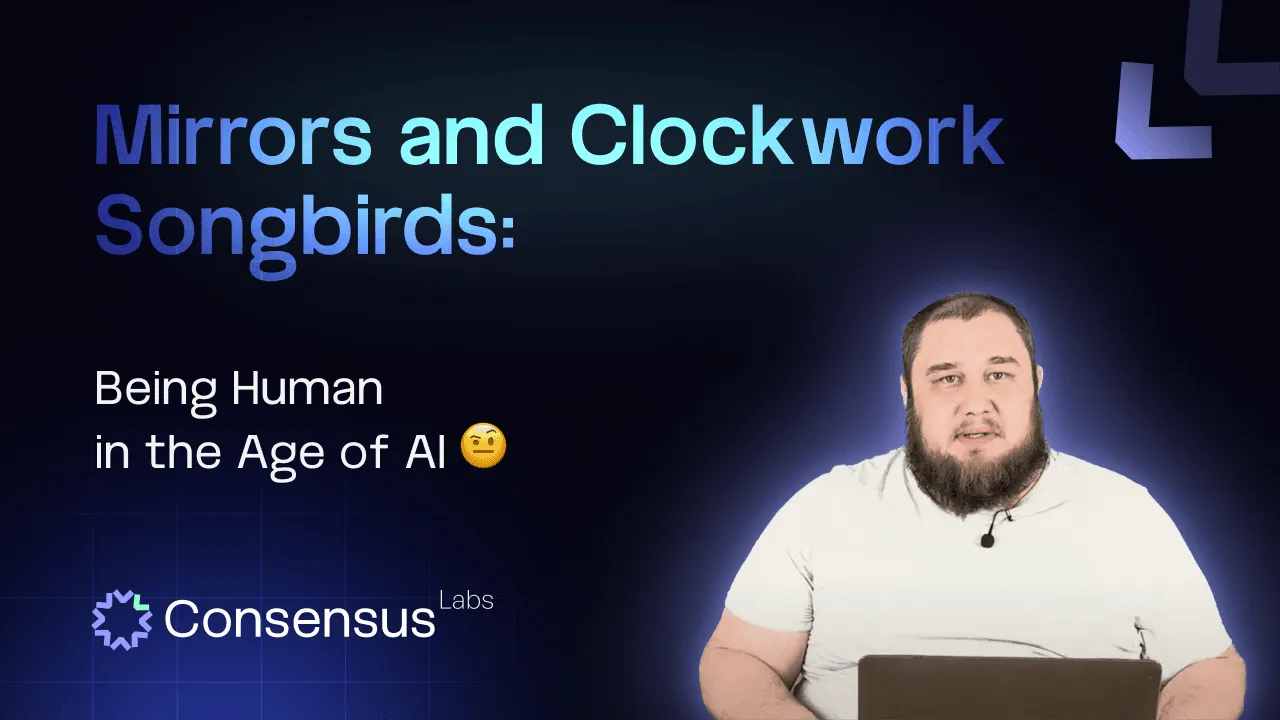Embracing Imperfection: What It Means to Be Human in the AI Age
In an era where artificial intelligence (AI) powers everything from our daily routines to groundbreaking innovations, it’s easy to get caught up in the allure of efficiency. AI excels at streamlining processes, predicting outcomes, and eliminating errors with a precision humans can only dream of. But what if the very things AI strips away—our flaws, our inefficiencies—are what make us uniquely human? At Consensus Labs, we’re not just exploring what AI can do; we’re asking a deeper question: What can’t it do, and why does that matter?
AI as a Mirror: Reflecting Efficiency, Missing Essence
Picture AI as a mirror. It reflects a polished version of us—our logical patterns, our data-driven decisions, our optimized workflows. It’s a clockwork songbird, singing a perfect tune on repeat, never missing a note. But that reflection is incomplete. AI sharpens what we feed it—numbers, systems, tasks—but it doesn’t capture the messy, beautiful chaos of human experience. It can’t wind itself up or decide to change its song. It lacks the ability to feel need, to dream, or to create from imperfection.
This limitation isn’t a flaw in AI; it’s a feature. AI thrives on efficiency, but efficiency alone doesn’t tell the whole story of who we are. Our humanity lies in the gaps—the detours, the trial and error, the moments where things don’t quite work. These are the spaces where innovation is born.
The Power of Inefficiency: Lessons from History
Think about some of humanity’s greatest leaps forward. They didn’t come from perfection; they emerged from need, fueled by the inefficiencies of the moment.
Take agriculture, for instance. Over 12,000 years ago, early humans didn’t invent farming because it was the most efficient way to eat—it wasn’t. It was backbreaking, unpredictable, and riddled with failures. But the nomadic life had gaps: unreliable food sources, unstable climates, scattered resources. That imperfection sparked a need for stability, driving humans to plant seeds and tend the earth. What started as an inefficient solution laid the foundation for civilization itself—not through a straight path, but through the messy, organic process of survival and adaptation.
Or consider the steam engine. In its infancy, it was little more than a curiosity—a clunky contraption spinning a wheel with no clear purpose. It wasn’t efficient, and it didn’t solve an immediate problem. Yet that lack of practicality gave it room to grow. Through years of tinkering and vision, it evolved into the powerhouse of the Industrial Revolution, driving trains and transforming societies. Its inefficiency wasn’t a dead end; it was an open door.
Then there’s space exploration. Why did we go to the moon? Not for efficiency—there was no logical “need” to justify the cost or risk. It was a need born of wonder, a desire to push beyond our limits and touch the unknown. AI could optimize a rocket’s trajectory, but it could never dream of the stars.
Humans as Creators of Vision
What ties these stories together is this: Humans don’t just solve problems; we create them. We see gaps where others see dead ends. We ask, “What’s missing?” and then build something new to fill it. AI can refine our solutions—it can make them faster, smoother, better—but it can’t imagine the need in the first place. That’s where we shine.
Our imperfections aren’t obstacles to overcome; they’re invitations to create. The arts, technology, social change—none of these sprang from a perfect system. They came from recognizing flaws, feeling unease, and daring to envision something different. AI can’t replicate that. It’s a tool, not a visionary.
Embracing the Gaps in the AI Age
So, what does this mean for us today, as AI becomes an ever-present partner in our lives? It’s a reminder that being human isn’t about chasing perfection. It’s about leaning into our flaws and asking what they can teach us. Efficiency is valuable, but it’s not the endgame. The future isn’t shaped by streamlined processes alone—it’s forged in the spaces where we stumble, where we dream, where we see possibility in failure.
At Consensus Labs, we’re building AI that pushes boundaries, but we’re also celebrating what makes us human. The next time you face an imperfection—a glitch, a detour, a moment of doubt—don’t rush to fix it. Pause and ask: What vision could this lead me toward? Because in the age of AI, it’s our humanity—flaws and all—that will continue to light the way.
Watch the Full Discussion
Want to dive deeper into this idea? Check out our latest video, “Mirrors and Clockwork Songbirds: Being Human in the AI Age,” on our YouTube channel. Barış takes the lead this time, exploring how our imperfections drive innovation and what it truly means to be human in a world of artificial intelligence. Watch it below and let us know your thoughts—what inefficiencies inspire your own creativity?

